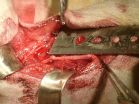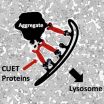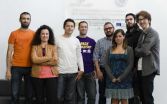Immune cell's role in intestinal movement may lead to better understanding of IBS
2014-07-18
(Press-News.org) Learning the role of immune-system cells in healthy digestive tracts and how they interact with neighboring nerve cells may lead to new treatments for irritable bowel syndrome (IBS). Researchers from Penn State College of Medicine, in collaboration with other scientists, have reported the role of macrophages in regulating the contractions of the colon to push digested material through the digestive tract.
The muscular lining of the intestine contains a distinct kind of macrophage, an immune system cell that helps fight infections. The role of these cells in normal colon function is not known, although they have been linked to inflammation after abdominal surgery.
"Very little is known about the function of muscularis macrophages, mainly because these cells are difficult to isolate from intestinal tissue," said Milena Bogunovic, assistant professor of microbiology and immunology.
Digested material is moved through the intestines by the contraction and relaxation of intestinal muscles. The pattern and frequency of these contractions are controlled by the signals from the intestinal nervous system. In patients with diseases like IBS, the signals are overactive and stimulation is exaggerated.
The researchers developed a method to deplete muscularis macrophages in the intestines of mice to determine their function. They report their findings in the journal Cell.
"After macrophage depletion, we observed that the normal intestinal movements are irregular, probably because the muscular contractions were poorly coordinated, suggesting that intestinal movements are regulated by macrophages," Bogunovic said.
After confirming the role of the macrophages in the function of the digestive tract, the researchers looked for how the regulation happens. They compared the genetic code of different types of macrophages to find non-immune genes highly active in muscularis macrophages, identifying bone morphogenetic protein 2. BMP2 is one of a family of proteins thought to control organ development.
Blocking the effect of BMP2 mirrored the effects of the macrophage removal, confirming that the protein is used for regulation of intestinal movements. The BMP2 is used by neighboring nerve cells, intestinal neurons, which in turn secrete a protein called colony stimulatory factor 1 (CSF1) that supports macrophages.
"Two completely different cell types help each other to carry one key function, to regulate the physiology of the gut," Bogunovic said.
The interactions between the two cells types are orchestrated by the "good" bacteria in the intestine that aids in healthy digestion.
By giving mice antibiotics to kill off the bacteria, the communication between macrophages and neurons is interrupted resulting in decreased BMP2 and CSF1 production and disrupted intestinal contractions.
By restoring the "good" bacteria in the mice, the miscommunication between macrophages and neurons is reversed, showing that the dialogue between the macrophages and nervous system is adaptable to the changes in the bacterial environment.
A potential cause of IBS is a change in the bacterial environment in the intestine.
"By better understanding how the nervous system cells, the muscularis macrophages and signals from inside the intestine interact, we may be able to find new treatments for IBS, or even prevent it," Bogunovic said.
INFORMATION:
Other researchers on the project are Paul Andrew Muller, Marie-Luise Berres, Miriam Merad, Daigo Hashimoto, Arthur Mortha, Xiu-Min Li, Marylene Lebouef, Stephanie Dahan, Icahn School of Medicine at Mount Sinai Hospital; Balazs Koscso, postdoctoral scholar, Penn State College of Medicine; Gaurav Manohar Rajani, research assistant, Penn State College of Medicine; Korey Stevanovic and Kara Gross Margolis and David Gershon, Columbia University College of Physicians and Surgeons; Daniel Mucida, The Rockefeller University; and E. Richard Stanley, Albert Einstein College of Medicine.
The National Institutes of Health and Crohn's & Colitis Foundation of America funded this research.
ELSE PRESS RELEASES FROM THIS DATE:
It's go time for LUX-Zeplin dark matter experiment
2014-07-18
New Haven, Conn. -- From the physics labs at Yale University to the bottom of a played-out gold mine in South Dakota, a new generation of dark matter experiments is ready to commence.
The U.S. Department of Energy's Office of Science and the National Science Foundation recently gave the go-ahead to LUX-Zeplin (LZ), a key experiment in the hunt for dark matter, the invisible substance that may make up much of the universe. Daniel McKinsey, a professor of physics, leads a contingent of Yale scientists working on the project.
"We emerged from a very intense competition," ...
Improving driver safety: How to prevent streetlight glare in the new world of LED lighting
2014-07-18
WASHINGTON, July 18—Long hours of nighttime driving can cause eyestrain because while our vision adapts to the surrounding darkness, the sudden stabs of brightness from streetlamps can be irritating, distracting and even painful. Even as LED technology has transformed the lighting industry, bringing the promise of more energy-efficient road illumination, some fear that the new lights could cause even more troublesome, unsafe glare.
A team of researchers from China and the Netherlands has developed a way to evaluate the human impact of uncomfortable glare caused by LED ...
NASA sees super typhoon Rammasun eyeing landfall
2014-07-18
Imagery from NASA's Aqua satellite captured a wide-eyed Typhoon Rammasun as it was making landfall in northern Hainan Island, China early on July 18. A rainfall analysis using another NASA satellite showed the flooding potential of the storm as it left the Philippines and headed for China. Now, Rammasun is headed for a final landfall near the northeastern border of Vietnam and China.
On July 17, an analysis of Typhoon Rammasun's rainfall was conducted at NASA's Goddard Space Flight Center in Greenbelt, Maryland. The rainfall analysis covered the storm's rainfall from ...
NASA satellite catches birth of Tropical Storm Wali near Hawaii
2014-07-18
The first tropical cyclone of the season has formed in the Central Pacific Ocean as NASA's Terra satellite passed overhead. Tropical Storm Wali formed southeast of the Big Island of Hawaii, and now that it's nearing, a Flash Flood Watch has been posted for all of the islands.
NASA's Terra satellite passed over Wali on July 17 at 19:55 UTC (3:55 p.m. EDT) just as it was being classified as Tropical Depression 1C. NOAA's Central Pacific Hurricane Center (CPHC) issued an advisory at 5 p.m. EDT (11 a.m. HST) announcing the birth of the depression near 12.7 north and 140.7 ...
A rhesus monkey model of radial nerve injury for evaluating peripheral nerve repair
2014-07-18
Current research on bone marrow stem cell transplantation and autologous or xenogenic nerve transplantation for peripheral nerve regeneration has mainly focused on the repair of peripheral nerve defects in rodents. Dr. Dong Wang and his team, First Affiliated Hospital of Sun Yat-sen University, China established a standardized experimental model of 2.5 cm-long radial nerve defects in rhesus monkeys and evaluated the effect of repair on peripheral nerve injury. The quality of nerve regeneration in the bone marrow stem cells-laden allografts was comparable to that achieved ...
Intranasal nerve growth factor repairs injured spinal cord neurons
2014-07-18
Nerve growth factor can be delivered to the brain by intranasal administration without risk for treatment of brain diseases. Dr. Luigi Aloe, Cellular Biology and Neurobiology Institute, National Research Council, Italy and his team performed a study to investigate whether, by intranasal administration, the nerve growth factor bypasses the blood-brain barrier and turns over the spinal cord neurons. Results showed that at 3 weeks after intranasal administration of nerve growth factor, the contents of nerve growth factor and its receptor in the spinal cord were increased, ...
How does L-carnitine maintain the normal structure of sciatic nerve in crush injury?
2014-07-18
Several studies have demonstrated that L-carnitine exhibits neuroprotective effects on injured sciatic nerve of rats with diabetes mellitus. Dr. Ümmü Zeynep Avsar, Faculty of Medicine, Ataturk University, Turkey and his team proposed a hypothesis that L-carnitine exhibits neuroprotective effects on injured sciatic nerve of rats. Rat sciatic nerve was crush injured by a forceps and exhibited degenerative changes. After intragastric administration of 50 and 100 mg/kg L-carnitine for 30 days, axon area, myelin sheath area, axon diameter, myelin sheath diameter, and numerical ...
Novel mechanism for invasion of EV71 virus demonstrated
2014-07-18
A new study determines glycosylation and pH-dependent conformational changes of virus receptor SCARB2 as crucial for EV71 attachment, entry and uncoating
Enterovirus 71 (EV71) is the major causative agent of hand, foot and mouth disease (HFMD) in the Asia-Pacific region, having caused 8.8 million infections and 3,000 deaths in China in the past five years. Unlike other enteroviruses (e.g. Coxsackievirus), EV71 can cause severe aseptic meningitis, encephalitis, myocarditis and acute flaccid paralysis, thus leading to significant fatality rates. Unfortunately, the molecular ...
A new cellular garbage control pathway with relevance for human neurodegenerative diseases
2014-07-18
This news release is available in German.
Proteins, the components of our body that execute, control and organize basically all functions in our cells, are made out of strings of amino acids, which – like an origami - are folded into specific and complex three-dimensional structures according to their desired functions. However, since folding and maintaining of such structures is highly sensitive to cellular or environmental stress, proteins can potentially misfold or form clumps (aggregates). Such undesired protein waste can be toxic for cells and may even lead ...
New inexpensive and easy computer software provides real-time and highly accurate data on traffic
2014-07-18
Researchers at the University of Granada have designed new software that provides real time data on traffic. It is a device that provides information on traffic flow between cities. Drivers can use this information to choose the fastest route as they plan to drive to their destinations.
It is a highly reliable, low-cost method, easy and quick to install, which uses bluetooth devices. These devices collect real-time data on road traffic which it then sends to a central server. This information is then processed using complex data mining algorithms, evolutionary computing ...





